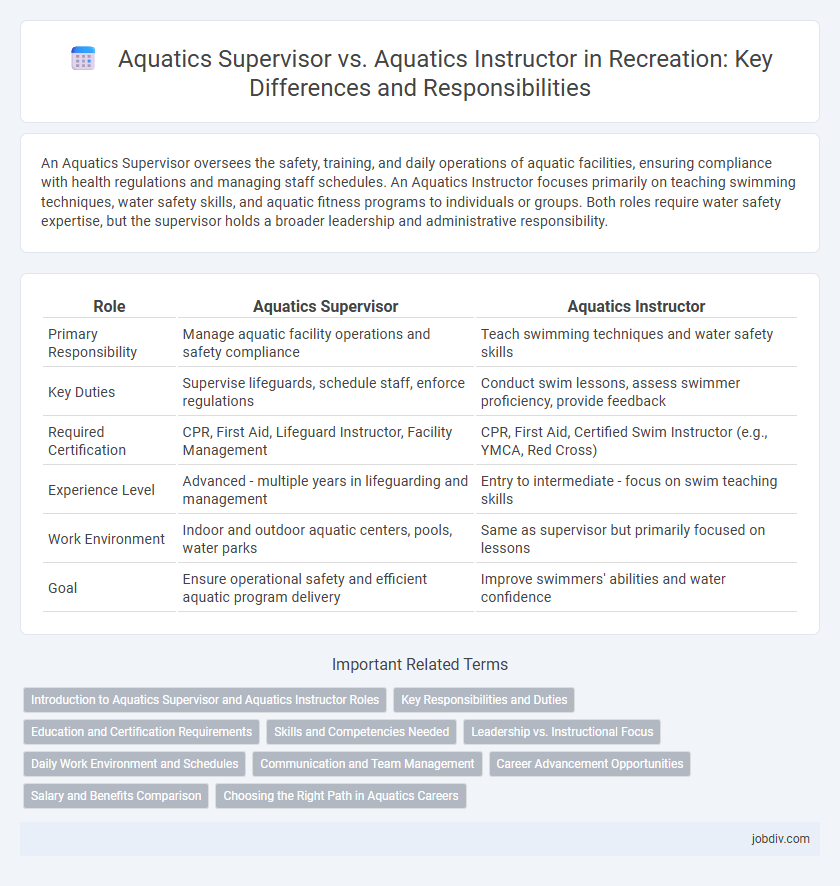An Aquatics Supervisor oversees the safety, training, and daily operations of aquatic facilities, ensuring compliance with health regulations and managing staff schedules. An Aquatics Instructor focuses primarily on teaching swimming techniques, water safety skills, and aquatic fitness programs to individuals or groups. Both roles require water safety expertise, but the supervisor holds a broader leadership and administrative responsibility.
Table of Comparison
| Role | Aquatics Supervisor | Aquatics Instructor |
|---|---|---|
| Primary Responsibility | Manage aquatic facility operations and safety compliance | Teach swimming techniques and water safety skills |
| Key Duties | Supervise lifeguards, schedule staff, enforce regulations | Conduct swim lessons, assess swimmer proficiency, provide feedback |
| Required Certification | CPR, First Aid, Lifeguard Instructor, Facility Management | CPR, First Aid, Certified Swim Instructor (e.g., YMCA, Red Cross) |
| Experience Level | Advanced - multiple years in lifeguarding and management | Entry to intermediate - focus on swim teaching skills |
| Work Environment | Indoor and outdoor aquatic centers, pools, water parks | Same as supervisor but primarily focused on lessons |
| Goal | Ensure operational safety and efficient aquatic program delivery | Improve swimmers' abilities and water confidence |
Introduction to Aquatics Supervisor and Aquatics Instructor Roles
Aquatics Supervisors oversee the safety protocols, staff management, and operational logistics within swimming facilities, ensuring compliance with health regulations and emergency preparedness standards. Aquatics Instructors focus on teaching swimming techniques, water safety skills, and swimming lesson progression tailored to various age groups and skill levels. Both roles collaborate to maintain a secure, educational, and enjoyable aquatic environment, yet each requires specialized training in leadership or instructional methods respectively.
Key Responsibilities and Duties
An Aquatics Supervisor oversees the overall operation and safety of aquatic facilities, managing staff, enforcing policies, and coordinating emergency responses to ensure a secure environment. An Aquatics Instructor focuses on teaching swimming techniques, water safety, and lifesaving skills to individuals or groups, tailoring lessons to various age groups and skill levels. While supervisors handle administrative and safety oversight, instructors are directly responsible for instructional delivery and participant skill development.
Education and Certification Requirements
Aquatics Supervisors typically require advanced certifications such as a Lifeguard Instructor, CPR Instructor, and often a degree in recreation management or a related field, emphasizing leadership and safety oversight. Aquatics Instructors generally need foundational certifications like American Red Cross Swimming Instructor or YMCA Swim Instructor, focusing on swimming techniques and water safety skills. Both roles may require ongoing education in first aid, water rescue, and child safety to maintain credentials and ensure effective aquatic program delivery.
Skills and Competencies Needed
An Aquatics Supervisor requires strong leadership, risk management, and staff coordination skills to oversee pool safety and operations effectively. An Aquatics Instructor must possess excellent swimming techniques, teaching abilities, and the capacity to assess and improve swimmers' skills. Both roles demand strong knowledge of water safety regulations and emergency response protocols.
Leadership vs. Instructional Focus
An Aquatics Supervisor manages facility operations, staff scheduling, and safety protocols, emphasizing leadership and administrative oversight to ensure smooth aquatic program delivery. In contrast, an Aquatics Instructor concentrates on direct teaching, skill development, and participant engagement, focusing on instructional techniques and water safety education. Both roles are essential in aquatics, balancing leadership responsibilities with hands-on instruction to create safe and effective swimming environments.
Daily Work Environment and Schedules
Aquatics Supervisors typically manage facility operations, oversee staff schedules, and ensure safety protocols are enforced throughout a 40-hour workweek that often spans early mornings to late evenings. Aquatics Instructors conduct swim lessons and training sessions, with daily schedules focused on direct interaction with participants, commonly working part-time or variable hours aligned with class times. The work environment for Supervisors involves more administrative tasks and risk management, while Instructors engage in hands-on teaching within poolside settings.
Communication and Team Management
An Aquatics Supervisor excels in communication by coordinating between staff, lifeguards, and management, ensuring clear directives and safety protocols are maintained. Their team management skills involve overseeing scheduling, training, and performance evaluations to optimize aquatic facility operations. In contrast, an Aquatics Instructor focuses communication on delivering clear, motivating guidance to swimmers while managing small groups to enhance skill development and water safety.
Career Advancement Opportunities
Aquatics Supervisors oversee facility operations and staff management, offering leadership roles and broader career advancement in recreation management. Aquatics Instructors focus on teaching swimming skills and water safety, which provides foundational experience but fewer advancement opportunities without additional certifications. Progression from Instructor to Supervisor often requires certifications such as the YMCA Leadership Development or Aquatic Facility Operator (AFO) credential.
Salary and Benefits Comparison
Aquatics Supervisors typically earn higher salaries, ranging from $45,000 to $70,000 annually, compared to Aquatics Instructors who earn between $25,000 and $40,000. Benefits for Aquatics Supervisors often include comprehensive health insurance, retirement plans, and paid leave, whereas Aquatics Instructors may receive limited benefits or part-time status without full coverage. Supervisors also gain opportunities for bonuses and career advancement that enhance total compensation beyond base salary levels.
Choosing the Right Path in Aquatics Careers
Choosing the right path in aquatics careers depends on your leadership skills and passion for teaching. An Aquatics Supervisor manages facility operations, staff coordination, and safety protocols, requiring strong administrative abilities. In contrast, an Aquatics Instructor focuses on delivering swim lessons and skill development, emphasizing direct interaction with swimmers and instructional expertise.
Aquatics Supervisor vs Aquatics Instructor Infographic

 jobdiv.com
jobdiv.com